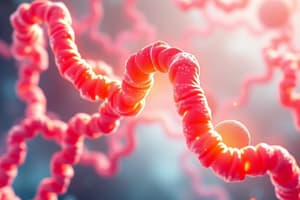Podcast
Questions and Answers
What is formed when two amino acids are covalently linked via a peptide bond?
What is formed when two amino acids are covalently linked via a peptide bond?
- Protein
- Polypeptide
- Peptide (correct)
- Tripeptide
Which of the following best describes the mechanism of covalent bonds?
Which of the following best describes the mechanism of covalent bonds?
- Hydrogen bonding
- Mutual dipole induction
- Electron sharing (correct)
- Coulombic attraction
What change does applying heat to proteins typically cause?
What change does applying heat to proteins typically cause?
- Enhances enzyme activity
- Facilitates protein digestion (correct)
- Stabilizes protein structure
- Increases protein synthesis
Which type of bond involves hydrogen being shared between molecules?
Which type of bond involves hydrogen being shared between molecules?
How does a change in physiological pH affect protein structure?
How does a change in physiological pH affect protein structure?
Which of the following is NOT a significant factor in the denaturation of proteins?
Which of the following is NOT a significant factor in the denaturation of proteins?
What interaction type is characterized by mutual dipole induction among non-polar groups?
What interaction type is characterized by mutual dipole induction among non-polar groups?
What is the energy range for covalent bonds according to their binding forces?
What is the energy range for covalent bonds according to their binding forces?
Flashcards
Peptide Bond
Peptide Bond
A covalent bond formed between the α-amino group of one amino acid and the carboxyl group of another amino acid. The reaction involves the removal of a water molecule.
Primary Structure
Primary Structure
The sequence of amino acids in a polypeptide chain. It is the most basic level of protein structure.
Protein Denaturation
Protein Denaturation
The process of unfolding or disrupting the native conformation of a protein, leading to loss of its biological activity.
Detergent
Detergent
Signup and view all the flashcards
Heat Denaturation
Heat Denaturation
Signup and view all the flashcards
pH Denaturation
pH Denaturation
Signup and view all the flashcards
Electrostatic Interaction
Electrostatic Interaction
Signup and view all the flashcards
Hydrogen Bond
Hydrogen Bond
Signup and view all the flashcards
Study Notes
Peptide and Peptide Bonds
- Amino acids link covalently, forming amide bonds (peptide bonds) between the α-amino and carboxyl groups.
- Peptide bonds create peptides, and multiple peptides form proteins.
- A dipeptide is formed when two amino acids join; an example is Gly-Ala.
- Peptide bond formation is a simplified dehydration reaction producing a new molecule.
Protein Structure
3.5.2 Primary Structure
- The primary structure is the first level of protein organization.
3.6.2 Denaturation by Temperature Changes
- Heating is a common denaturing agent for proteins in food, aiding digestion and neutralizing enzyme inhibitors.
3.6.3 Denaturation by pH Changes
- Changes in pH modify protein conformation through altered ionization of charged side chains.
- This affects salt bridges, which are crucial for protein structure.
3.6.5 Denaturation by Detergents
- Detergents like SDS are vital in protein studies for their denaturing abilities.
- SDS works through amphiphilic properties.
Studying That Suits You
Use AI to generate personalized quizzes and flashcards to suit your learning preferences.




